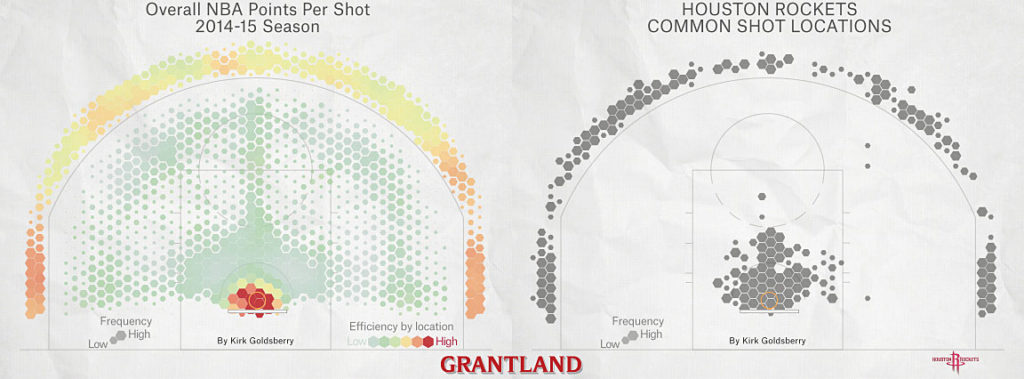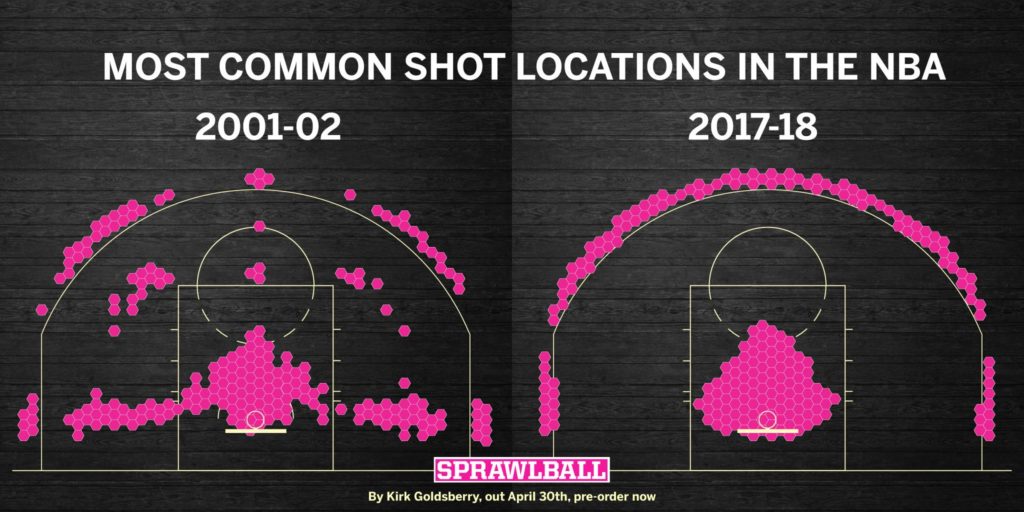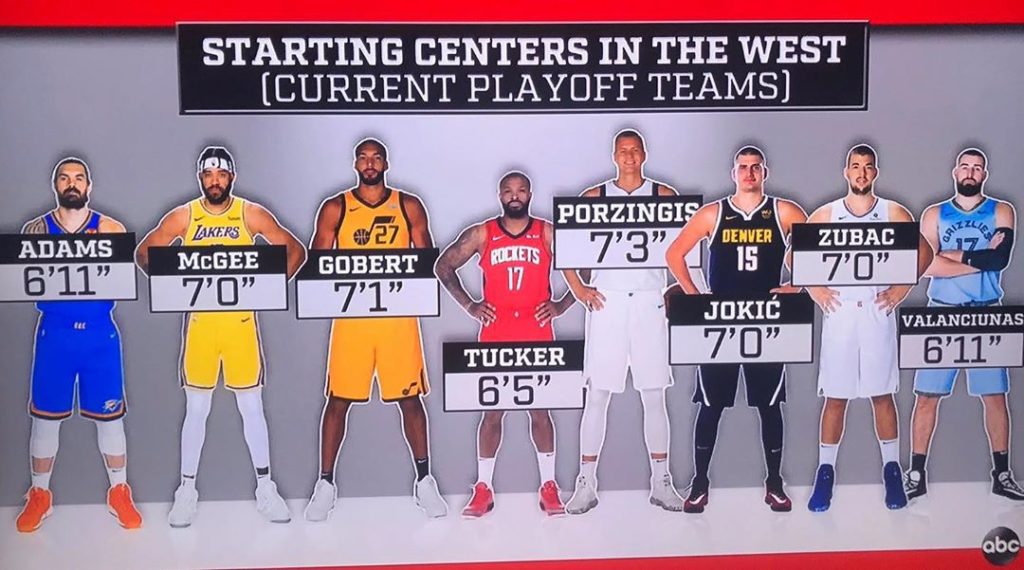What Happens When “MoreyBall” Encountered Repeated Games

MoreyBall analytics works for Houston Rockets and changes the way the NBA is played. However, does it really help them in the playoffs?
Reaction to “Houston Rockets and ‘MoreyBall'”, By RobD
Although baseball was the first sport in the U.S. to fully internalize analytics-heavy strategies and techniques and adapt them into the operation, “Moneyball” was a more heated topic in the world of basketball back in China, where the Rockets have an extensive relationship after the selection of Yao Ming in 2002. I could still remember Rocket fans complained about team owner’s decision on Hupu (the Chinese version of Reddit), about hiring Daryl Morey, a data geek with non-traditional basketball backgrounds, as the general manager.
These complaints dwindle into trifles when they realized that in Morey’s tenure, Rockets have not had a losing record and have advanced to the playoffs 9 times, including to the Western Conference Finals in 2015 and 2018. More and more people started to study “MoreyBall” and the three main tenets of it are concluded by RobD as 1) playing fast (increase the number of possessions in a game), 2) shooting only two (and a half) types of shots (dunk/layups, foul shots (the half), and 3-pointers), and 3) defensive flexibility (acquiring versatile athletes who can defend many positions on the floor and avoiding the purchase of expensive Centers. The three pictures below depict that the whole league is converging to the second principle of “MoreyBall” but not necessarily the third.



Despite the fact that the data analytics help rockets gain success during the regular season last decade, their postseason performance has consistently received criticism. Why is that? I believe this has something to do with the nature of NBA playoffs – you need to play against the same team for 4-7 games in a single series in a relatively short time (7 games in two weeks). Below I will talk about some risks inherited in “MoreyBall” which could be amplified during playoffs.
Volatility v.s Mean
Most of the time we are focusing on the first moment, which is mean, of variables when we build the model and make predictions. I believe Morey did the same thing to gauge the efficiency of shots and Rockets’ regular-season records justified his model. In the regular season, teams are keen to use the most cost-effective strategy to secure the playoff seeds by and Morey seemingly provides the panacea for them. However, one can not simply neglect how volatilities could influence the output when the team is playing against the same opponent in a series. I don’t know if Mr. Morey accounts volatilities into his calculation, but history has witnessed No.8 seeds upsetting No.1 seeds not on only once. People may call it “mental breakdowns”, while I am more intrigued to describe it as the lack of observation of high volatility against certain opponents. A team may have the best record in the league, but they can easily be doomed it they have very unstable performance in the playoffs.
Not a Static Model
The whole idea of “MoreyBall” is about creating a math advantage by attempting so many more of their shots from the most efficient areas than any other team. Nevertheless, the defenders can give pressure on you all the time in the game of basketball, which is different from football or baseball. The coach of the opposing team can simply watch the game video beforehand and let his player push rocket’s players away from their sweet spots. Believe me, if a player hasn’t attempted the “inefficient” shots for several months in a real game, the success rate of an unguarded midrange shot to him could just be like the status of Schrödinger’s cat to us.
“People” Analytics
Morey acquires or drafts players who can both shoot and/or drive to the basket and play switch-happy defense based on his analytics, but like Prof. Polzer said, “people are noisy”. I would totally buy “Moreyball” if the players are robots. In reality, there are so many unobserved characteristics that can alter the robustness of the model. For example, a player is not able to perform as usual offensively if he is picked up for a 1-1 match on the defense side. He might fall into foul trouble or get too tired to play aggressively during the offense. Another problem of “Moreyball” is the heterogeneity of role players. They are only asked to finish the offense, like shooting 3-points or dunks, but the star player in a team usually initiate offense drills. The whole system is likely to get stuck if the star player is forced to sit on the bench due to injuries or foul trouble. In addition, impatience is very infectious in the game. Guess what would happen if none of your team could make 3-pointers, the most efficient shots? Morey might have started thinking of revising his model already after he saw his team missed 27 consecutive 3-pointers.



I think the trend toward 3s, dunks, and free throws is here to stay… much to the chagrin of many NBA fans. As you stated, the expected points per shot are highest there. Data analytics and Morey have certainly moved the needle there, and I would argue they have pushed teams toward flexibility on the defensive end as well… with more successful teams stocking up on players 6’5-6’10 who can switch onto any position. However, I agree that the playoffs are a different beast from the regular season. Most teams in the NBA have a massive center, and a relatively massive power forward, and the rest of the roster sort of swaps in and out. I believe the playoffs are exactly why. In a typical season, the playoffs arrive after a grueling 82 game stretch, and then teams launch into 7 game series. having massive humans requires other teams to expend effort preventing those massive humans from rebounding, and scoring in the paint. The Rockets suffer in these areas in the playoffs, and are thus extremely reliant on making shots and on refs calling fouls. If you can’t rebound, and you aren’t going to score in the paint, you better make your 3s! And as you mentioned, 3s come and go. If you have two bad games or even a single bad game from 3 point land, that can cost you a series. Without big men, there is no back up plan, and no good way to adjust mid series or mid game.
For those interested in sports analytics, the political analytics team at FiveThirtyEight also does some really great sports coverage as a side hobby: https://fivethirtyeight.com/sports/
It is super interesting to see the connection of analytics and game theory at work. Now that MoreyBall is in the open, the Rockets general strategy is laid bare, and teams can proactively develop strategies to combat the tactic. This also highlights the risk of practically applying data insights. For one, organizations can only focus on a few changes at once, so MoreyBall is boiled down to basically a single offensive principle (3’s) and a single defensive principle (switches). Even if these are the best single tactics, is there a more nuanced strategy that would be more effective/robust. Also, I wonder how this impacts draft strategy. Typically teams go with a ‘best available’ strategy, but if that individual doesn’t fit your stereotyped needs, are you missing good talent?
I agree the intersection between analytics and competitive strategy is fascinating. Your article reminded me of some articles I’ve read about how the A’s Moneyball advantage wore off as everyone quickly figured out what they were doing. It seems the competitive advantage is NOT very sustainable in a repeated game. This goes against a lot of the popular discourse on the “competitive advantage of data”.